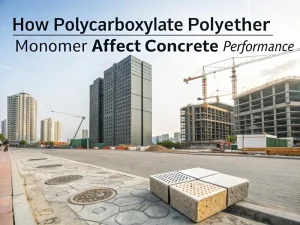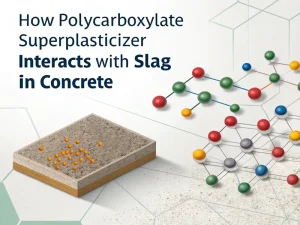Blog
Using chemical admixtures in concrete construction is crucial for improving the performance of concrete and managing its performance at various stages of construction. Among these admixtures, water reducing and retarding admixture are crucial in improving workability and controlling setting time, especially under challenging conditions.
Water reducing and retarding admixture are chemical substances added to concrete during the mixing process to achieve two main objectives:
Type | Primary Components | Water Reduction (%) | Retardation (Hours) | Typical Dosage (wt.% cement) |
Lignosulfonate-based | Modified lignin derivatives | 8-12 | About 3 | 0.2–0.3 |
Naphthalene-based | Sulfonated naphthalene polymers | 15-25 | 3-6 | 0.5–1.5 |
Polycarboxylate-based | Comb-type copolymers | 20-40 | 4-8 | 0.5-1.0
|
Retarding-based | citric acid, tartaric acid, and gluconic acid | / | Adjustable (2–12) | Generally 0.3 |
The most significant difference lies in their main functions.
Water reducing agents are mainly used to reduce the water required in concrete or mortar mixtures while maintaining the required workability. By reducing the water-cement ratio, they improve concrete’s strength, durability, and impermeability.
In contrast, retarders are mainly used to slow down the hydration process of cement, thereby delaying the setting time of concrete. This allows more time to place, compact, and complete the concrete.
Mixing water reducer and retarder can reduce rapid slump loss and flash setting when the ambient temperature exceeds 35°C. For example, the Burj Khalifa building in Dubai can maintain operability for 6 hours even if the on-site temperature is 45°C.
In the dam foundation, the combination of the two is used to control thermal cracking by delaying heat generation. The Three Gorges Dam project achieved a 12-hour delay window, reducing peak temperatures by 15°C.
Mixing water reducer and retarder can accurately control the demolding time.
The water reduction effect makes it possible to produce high-strength prefabricated components with lower water-cement ratios, reducing the overall weight of the components while maintaining their strength. The retarding property allows for better control of the production process, as it gives workers more time to process and shape the concrete before it sets.
One of the main challenges in using water reducers and retarders is ensuring their compatibility with other concrete mixture components, including different types of cement, aggregates, and other admixtures.
The precise dosage control of these additives is crucial. Incorrect dosage may not achieve the expected effect and may also hurt the performance of concrete. Excessive use of water reducing agents can lead to excessive slump and segregation. In contrast, excessive use of retarders can cause unacceptable delays in setting time, which may affect construction progress. Therefore, strict quality control measures should be taken to ensure the correct dosage of additives.
Some water reducing and retarding admixture, especially those with strong retarding effects, can lead to a decrease in the early strength of concrete.
The excellent working performance of water reducing water reducing and retarding admixture makes them important in various building applications. Although their use presents compatibility and dose control challenges, they can be overcome through appropriate testing and quality control. With the continuous development of the construction industry and the demand for higher performance and more sustainable building materials, the role of water reducers and retarders will only become more important in the future.

How Polycarboxylate Polyether Monomer Affect Concrete Performance
Blog How Polycarboxylate

How Polycarboxylate Superplasticizer Interacts With Slag In Concrete
Blog How Polycarboxylate